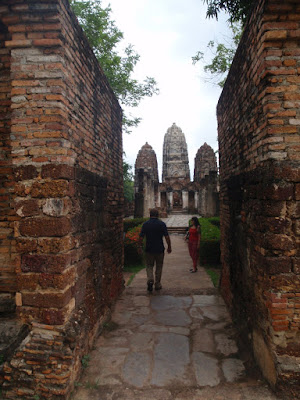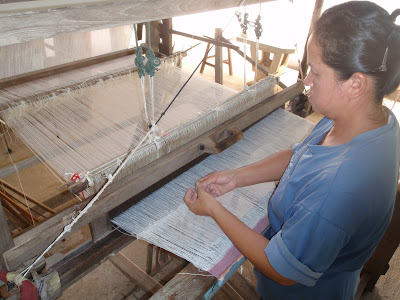
"Ree Thai Antique" near Thailand's ancient city of
 Next stop: Sukhothai [sook-oh-tie]
Next stop: Sukhothai [sook-oh-tie]This 13-14th century city in central/north Thailand was the capital during the 13th-14th centuries before moving to Ayudhya and later Bangkok. We felt it was high time we dropped in for a cup of chaa.
 Stopping en route for a drink at a roadside stall, we inadvertently discovered a Wat in a village called Pa Sang. It sported a small library, where Buddhist scrolls are normally stored. Its venerable age bestowed on it a dignified if slightly mouldy countenance:
Stopping en route for a drink at a roadside stall, we inadvertently discovered a Wat in a village called Pa Sang. It sported a small library, where Buddhist scrolls are normally stored. Its venerable age bestowed on it a dignified if slightly mouldy countenance: Having always promised ourselves a visit to Mae Sot, a border-crossing town into Burma, we diverted to it via the scenic route, by-passing Sukhothai for the moment:
Having always promised ourselves a visit to Mae Sot, a border-crossing town into Burma, we diverted to it via the scenic route, by-passing Sukhothai for the moment:
 Maesot turned out to be a multi-racial melting-pot: Thai, Burmese, Bangladeshi, Indian etc. Very interesting but it had a less-than-welcoming vibe - and the architecture was mundane - so we headed back towards Sukhothai and found a place to stay the night. Next day, early, we drove to the Old City and found some fabulously romantic ruins, between 600-700 years old. The basic building material was laterite, a porous volcanic rock. You can see some loose blocks being lifted by the roots of this tree:
Maesot turned out to be a multi-racial melting-pot: Thai, Burmese, Bangladeshi, Indian etc. Very interesting but it had a less-than-welcoming vibe - and the architecture was mundane - so we headed back towards Sukhothai and found a place to stay the night. Next day, early, we drove to the Old City and found some fabulously romantic ruins, between 600-700 years old. The basic building material was laterite, a porous volcanic rock. You can see some loose blocks being lifted by the roots of this tree:  Brenton urgently supplicates Phra Buddha to send a Sign (preferably not in Thai script) which might guide him to a half-decent Tiramasu shop within 100 kilometres. (No Revelation Scrolls in Brenton's spiritual Inbox yet).
Brenton urgently supplicates Phra Buddha to send a Sign (preferably not in Thai script) which might guide him to a half-decent Tiramasu shop within 100 kilometres. (No Revelation Scrolls in Brenton's spiritual Inbox yet).  Alan imagines the long wooden roof which once sat atop these pillars:
Alan imagines the long wooden roof which once sat atop these pillars:







 The only part of the seated Buddha left on this block [photo below] was a section of a foot and a hand. It was so deteriorated that it was difficult to photograph, but the worn outlines were there in stone. In another 100 years they may not be...
The only part of the seated Buddha left on this block [photo below] was a section of a foot and a hand. It was so deteriorated that it was difficult to photograph, but the worn outlines were there in stone. In another 100 years they may not be...  The many small recesses in this stupa are a cultural hangover from times before Buddhism evolved out of Hinduism:
The many small recesses in this stupa are a cultural hangover from times before Buddhism evolved out of Hinduism: I wondered about the original purpose of these symmetrical ponds...
I wondered about the original purpose of these symmetrical ponds... How very Khmer. The 3 stupas are pure Angkor, reminding one that the region known now as Thailand was once just an outpost of the Khmer (now Cambodia) kingdom:
How very Khmer. The 3 stupas are pure Angkor, reminding one that the region known now as Thailand was once just an outpost of the Khmer (now Cambodia) kingdom: The tiny Strangler Fig seedling germinating underneath this stone door lintel might just be the beginning of the end for this shrine. Have a peek at the gigantic figs presently destroying Ta Prohm at Angkor in Cambodia.
The tiny Strangler Fig seedling germinating underneath this stone door lintel might just be the beginning of the end for this shrine. Have a peek at the gigantic figs presently destroying Ta Prohm at Angkor in Cambodia.
 The Museum at Sukhothai Historical Park is worth an hour or so. Here are some pix from the garden outside the complex:
The Museum at Sukhothai Historical Park is worth an hour or so. Here are some pix from the garden outside the complex: A reconstruction of a pottery kiln:
A reconstruction of a pottery kiln: Sukhothai was a complete city, but only its religious buildings were constructed from stone - in order to last forever to protect concealed Buddha holy relics. Even the King's palace was wooden. There are remains of monasteries, tombs, stupas and Wats dotted over a huge area, but all other constructions have long since rotted away or been (ahem) otherwise mysteriously recycled. I just can't help thinking back to Ozymandias. Then northwards to Si Satchanali (Si is sometimes written Sri). This ancient city wasn't as manicured as Sukhothai, so its atmosphere seemed more natural and romantic to me.Here's a 14th century Wat to which I took a fancy: Wat Chang Lom, laid out like a mini Angkor Wat, itself a microcosm of the mythical Mount Meru:
Sukhothai was a complete city, but only its religious buildings were constructed from stone - in order to last forever to protect concealed Buddha holy relics. Even the King's palace was wooden. There are remains of monasteries, tombs, stupas and Wats dotted over a huge area, but all other constructions have long since rotted away or been (ahem) otherwise mysteriously recycled. I just can't help thinking back to Ozymandias. Then northwards to Si Satchanali (Si is sometimes written Sri). This ancient city wasn't as manicured as Sukhothai, so its atmosphere seemed more natural and romantic to me.Here's a 14th century Wat to which I took a fancy: Wat Chang Lom, laid out like a mini Angkor Wat, itself a microcosm of the mythical Mount Meru:





















































